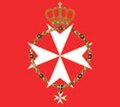 | |
| State Flag [1] | |
| Proportion | 2:3 |
|---|---|
| Adopted | 1259 |
| Design | A red field with the white Latin cross extending to the edges of the flag |
| Flag of the Order's Works | |
 | |
| Design | A red field with a white Maltese cross in the center |
| Grand Master's flag | |
 | |
| Design | Red with a white Maltese cross surrounded by the collar of the order and surmounted by a crown |
The flag and coat of arms of the Sovereign Military Order of Malta, or the Jerusalem flag, [2] display a white cross on a red field (blazon gules a cross argent), ultimately derived from the design worn by the Knights Hospitaller during the Crusades.
Contents
The flag represents the Sovereign Military Order of Malta as a sovereign institution. The state flag bears a Latin cross that extends to the edges of the flag. The flag of the Order's works represents its humanitarian and medical activities, and bears a white Maltese cross on a red field. Both flags together represent the Sovereign Military Order of Malta. Its constitution states: "The flag of the Order bears either the white Latin cross on a red field or the white eight-pointed cross (cross of Malta) on a red field." [3]












